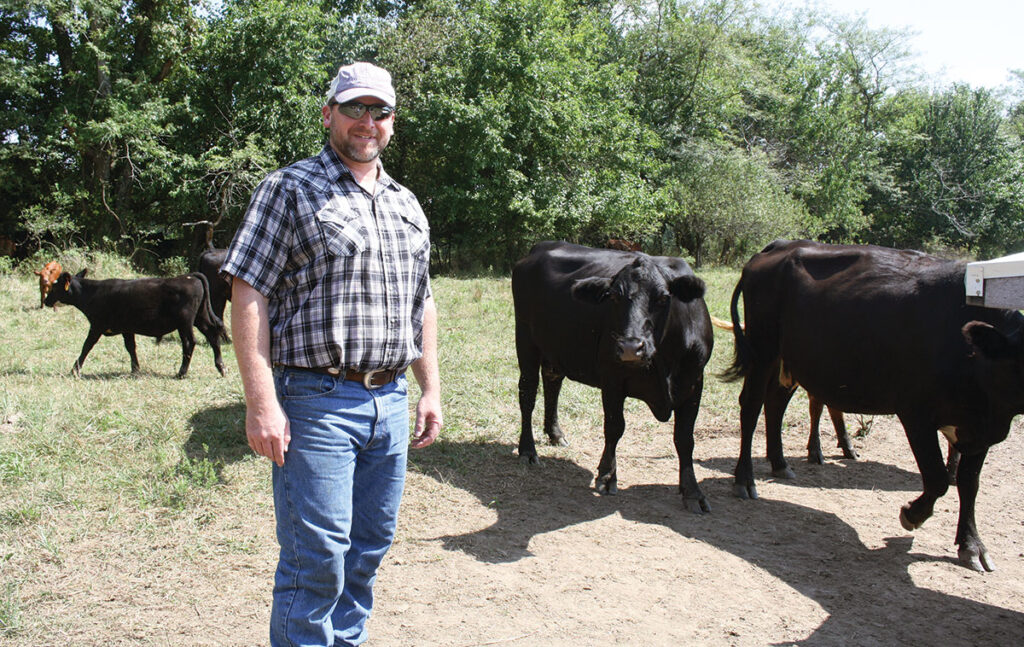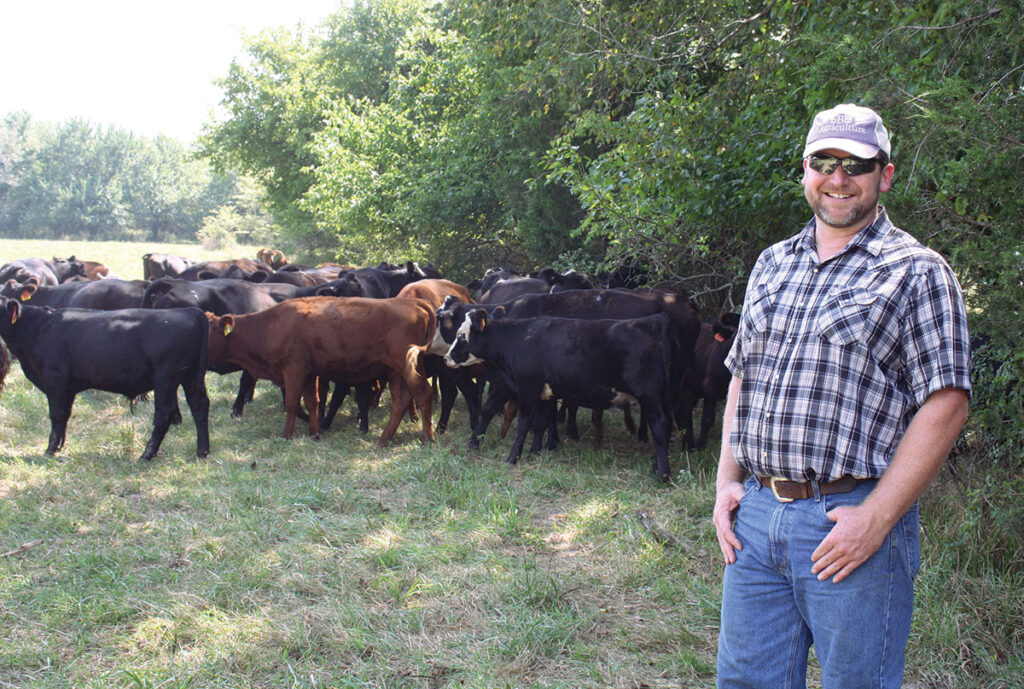
Cattleman John Murphy spearheads a new agriculture minor at Southwest Baptist University
BOLIVAR, MO. – Southwest Baptist University Associate Biology Professor John Murphy has a passion for agriculture, a passion he is now bringing to the students of the private-Christian university in Bolivar, Mo.
Armed with a Ph.D. in agronomy from Kansas State University, a master’s in biology from South Dakota State University, a bachelor’s in biology from the University of Central Missouri, as well as extensive professional and personal experience in agriculture, John has led the curriculum development for an agriculture minor.
“About five years ago, I had an interview with our Provost (Dr. Lee Skinkle), and he brought up the idea of an ag program,” John recalled. “I had thought about it, but we didn’t have one; SBU has never had one. One conversation turned into a bunch of conversations, and now, we’re rolling out an ag minor. I’m pretty excited because they let me design it from the ground up.”
The program will start with six classes in the spring of 2022, including a basic soils class, plant science classes focusing on pasture and forage development/management, and crop science.
“Everything we will look at in those classes will be based on what we have right here in Southwest Missouri,” John added. “We’re going to look at growing corn, soybeans and wheat, then at fescue and what you can use as alternative fall forages.”
On the animal science side, courses in beef production management and ruminant nutrition will be offered.
“One of the big things in beef production management will be getting all of the students involved with AI,” John said.
There have also been discussions about the development of an agriculture education program.
On his farm near Flemington, Mo., John is a practitioner of the lessons he offers students, operating a 200-head, forage-based commercial cow/calf operation on 800 acres with his family, including his wife Katie and their five children, Dan, Andrew, Kate, Jill and Ellen.
“One of the big things in beef production management will be getting all of the students involved with AI.”
— Professor John Murphy
“We have very little forested land,” John explained. “We have a hill that has an old cemetery on it, which is fenced off, but in all, we have about 750 acres of grass.”
When they purchased the property in 2007, the Murphys began to eradicate unwanted brush and other nuisance plants and started a fertilization program.
“We spread a lot of poultry litter,” he said. “We have crossed fenced all of our pastures, except one, to make about 20-acre pastures. We do rotate our pastures, and it makes it easy to move cattle around. We also don’t do any haying. I trade out brush hogging for a neighbor for hay. By doing that, we can use our fields for grazing, and we don’t have the fertility inputs you have to maintain your hay.”
The Murphys utilize both Angus and Red Angus sires in their breeding program.
“We try to run our bulls for 90 days for spring and fall calves,” John explained. “We are split about half and half on our herd, so we have calves to market year-round.”
Heifers are retained at the Murphy farm, with plans for about 34 to into the breeding program next spring.
“Our Red Angus is our heifer bull because they do better in the heat, and there is a large demand for those dark red replacement heifers,” John said. “We sell our fall steers as seven-weights, then that will clear out a pasture, so we can wean our spring calves, which we will sell around March.”
The Murphy herd grazes year-round unless there is heavy snow. They stockpile forages and strip grazing throughout the fall and winter months.
“We feed very little,” John said. “For our stockers, we feed mainly a mix of one-third dry distillers, one-third corn gluten, and a third soy hull pellets. We supplement at about .75 percent of body weight. We aren’t getting really fleshy calves, but they grow; that’s the market we have here. We aren’t finishing them, so I don’t want to over condition, but I want to feed enough, so they keep gaining during the summer.”

Calves are worked at about 90 days of age, which includes banding all bull calves, vaccinating against blackleg and the first round of BRD.
At weaning, nose flaps are placed in the noses of calves, which John said he has become a “big fan of.”
“It is a very quiet weaning and the easiest weaning I have ever done; the calves don’t push out, and the cows don’t push out,” John said. “We leave the nose flaps in for about 14 days and let them run with their mommas. We put some creep feeders out at that time to supplement them, and we let them wean themselves. After 14 days, we will leave the calves in the corral, and the mommas walk right back out; the weaning is done. About 28 to 30 days later, we will run them through for their second round of vaccinations. Then, they are kicked out to pasture. We do supplement them a little, but they are mostly on grass.”
The current supplement program is a medicated supplement with 6 percent phosphorus.
“That’s really about it,” John said. “Most of our cows don’t calve until the middle of March, so by the time they are coming into peak lactation, we are on green grass. The calves wean a little lighter and are a little younger, but for me, it pencils out.”
Because of the Murphys’ farming operation, SBU students get hands-on experience in agriculture and unique research opportunities. John currently has 14 students, all of which are pre-med students, in his research lab who utilize the farm and cattle for their projects.
“Two years ago, most of them had never touched a cow,” John said. “They come out, and they get used to being around cattle. They learn low-stress cattle handling, and they also learn how to pull blood samples.”
The implementation of nose-flap weaning began as a research project for six students.
“Most of my students didn’t know anything about agriculture other than what they read or what they’ve heard, and a lot of that is negative. Then they come out and see what it’s like, how we treat our animals and the expense we go to to care for our animals, and their view completely changes.”
— Professor John Murphy
“They wrote a grant and were funded by a national agency to research the stress of weaning, and they looked at the impact of traditional weaning and nose flaps. What they found was looking at cortisol, a stress hormone in the blood, there was no change in behavior in a nose-flapped calf and an unweaned calf. We presented that, and one of my students won a national award with it. This year, they are going to look at the impact of vaccinations on different weaning strategies.”
John said having the students at his farm is also a benefit for his farm.
“It’s going to force me to perform a little better,” he said with a laugh. “It forces you to look at new things. One of my research groups will look at a fescue-based system for heifers without so much concentrate. With corn and soybean prices, we can’t continue to do everything the same; it helps in being able to look at alternatives. I also like having people out here. I’ve been doing this here for 15 years and having someone else come out and say, ‘We’ve been doing this. Have you ever thought about it?’ No, but let’s try it.”
Excitement is building on campus for the program’s start, which may eventually lead to a four-year degree.
“We have to get started; you have to prove it can be done,” John said. “Most of my students didn’t know anything about agriculture other than what they read or what they’ve heard, and a lot of that is negative. Then they come out and see what it’s like, how we treat our animals and the expense we go to to care for our animals, and their view completely changes. I think we can bring that change to the SBU campus and have those conversations.”
John has high hopes for the SBU program and for his own farming operation, with plans to breed high-quality replacement heifers that do well on fescue and seeing future generations of the Murphy family follow his agriculture path.
“I want to pass this on to my kids,” he said. “I want my kids to have a love for agriculture and for them to continue to do what I do.”







